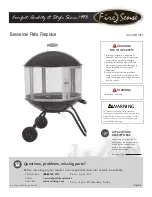
16
GI-IM048En-1013
B. SCALDING
This heater can deliver scalding water. Be careful whenever using hot water to avoid
scalding injury. Certain appliances, such as dishwashers and automatic clothes
washers may require increased water temperature. By setting the thermostat on this
heater to obtain the increased water temperature required by these appliances, you
may create the potential for scald injury.
To protect against injury, you should install a mixing valve in the water system. This
valve will reduce point of discharge temperature by mixing cold and hot water in
branch supply lines. Such valves are available from your local plumbing supplier.
Table 3
details the relationship of water temperature and time with regard to scald
injury and may be used as a guide in determining the safest water temperature for
your applications.
C. TEMPERATURE AND PRESSURE RELIEF VALVE
To avoid water damage or scalding due to relief valve operation:
Discharge line must be connected to relief valve outlet and run to a safe place of disposal. Terminate the discharge line in a
manner that will prevent possibility of severe burns or property damage should the relief valve discharge.
Discharge line must be as short as possible and the same size as the valve discharge connection throughout its entire length.
Discharge line must pitch downward from the valve and terminate at least 6” (15 cm) above the floor drain, making discharge
clearly visible.
The discharge line shall terminate plain, not threaded, with a material serviceable for temperatures of 375
o
F (191
o
C) or
greater.
Do not pipe discharge to any location where freezing could occur.
No shutoff valve may be installed between the relief valve and heater or in the discharge line. Do not plug or place any
obstruction in the discharge line.
Test the operation of the relief valve after filling and pressurizing the system by lifting the lever. Make sure the valve
discharges freely. If the valve fails to operate correctly, immediately replace with a new properly rated relief valve.
Test T&P valve at least once annually to ensure the waterway is clear. If valve does not operate, turn the heater “off”
and call
a plumber immediately.
Take care whenever operating relief valve to avoid scalding injury or property damage.
FAILURE TO COMPLY WITH THE ABOVE GUIDELINES COULD RESULT IN FAILURE OF RELIEF VALVE OPERATION,
RESULTING IN POSSIBILITY OF SUBSTANTIAL PROPERTY DAMAGE, SEVERE PERSONAL INJURY, OR DEATH.
Do not thread a cap or plug into the relief valve under any circumstances! Explosion and property damage, serious injury, or death may
result.
D. BACKFLOW PREVENTER
Use a backflow preventer specifically designed for water heater installations. This valve should be installed on the cold water fill supply
line per local codes.
E. POTABLE EXPANSION TANK
A potable hot water expansion tank is required to offset heated water expansion. In most city plumbing systems, the water meter has a
no return or back flow device built into the system to prevent back flowing of water into city mains. Some local codes require back flow
preventers on all incoming water supplies. The hot water expansion tank must be listed for potable water use. The expansion tank
should be located on the cold inlet piping close to the water heater.
Table 3
APPROXIMATE TIME / TEMPERATURE RELATIONSHIPS IN SCALDS
120
o
F (49
o
C)
More than 5 minutes
125
o
F (52
o
C)
1 ½ to 2 minutes
130
o
F (54
o
C)
About 30 seconds
135
o
F (57
o
C)
About 10 seconds
140
o
F (60
o
C)
Less than 5 seconds
145
o
F (63
o
C)
Less than 3 seconds
150
o
F (66
o
C)
About 1 ½ seconds
155
o
F (68
o
C)
About 1 second
Содержание UGC120S-100
Страница 36: ...36 GI IM048En 1013 Figure 18 LP LP ...
Страница 39: ...39 GI IM048En 1013 D INTERNAL WIRING DIAGRAM Figure 21 Wiring Diagram LP ...
Страница 40: ...40 GI IM048En 1013 Figure 22 LP 179 L LP ...
Страница 49: ...49 GI IM048En 1013 Figure 26 LP 179 J LP ...
Страница 50: ...50 GI IM048En 1013 Figure 27 LP 179 H LP ...
Страница 52: ...52 GI IM048En 1013 MAINTENANCE NOTES ...
















































